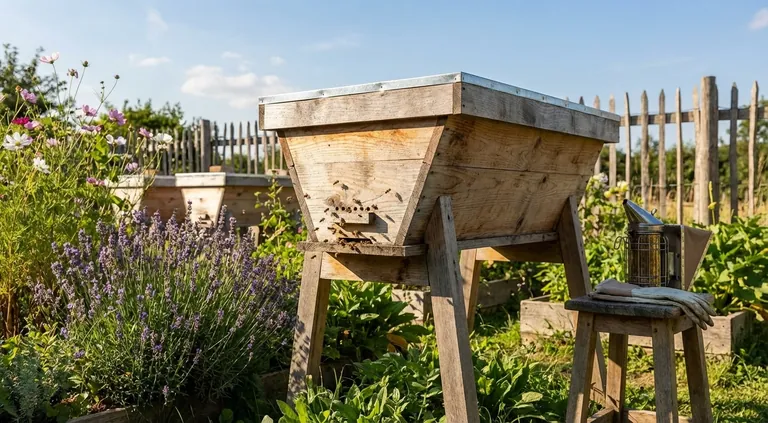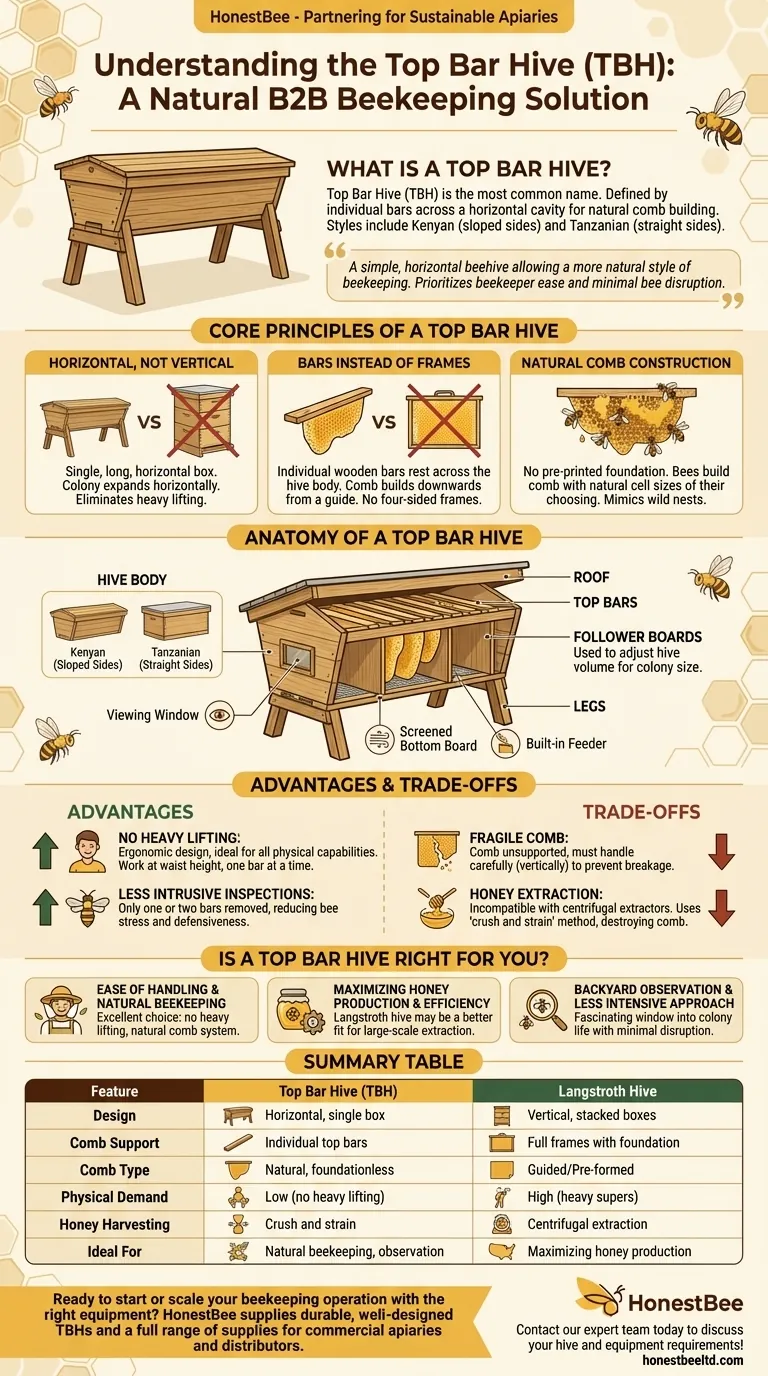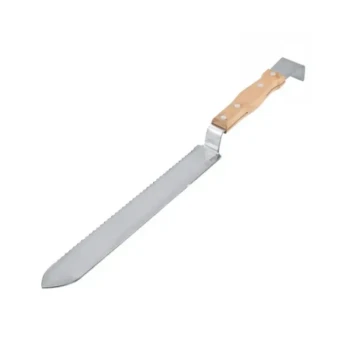A top bar hive is most commonly called a top bar hive, often abbreviated as TBH. While there are specific styles, such as the Kenyan hive (with sloped sides) and the Tanzanian hive (with straight sides), the general term "top bar hive" accurately describes this entire category of beehive design. It is fundamentally defined by the use of individual bars laid across the top of a horizontal cavity, from which bees build their comb naturally.
A top bar hive is a simple, horizontal beehive that allows for a more natural style of beekeeping. Its core design philosophy prioritizes ease of use for the beekeeper and minimal disruption for the bees, setting it apart from the more common stacked-box Langstroth hive.

The Core Principles of a Top Bar Hive
The top bar hive is the oldest and one of the most common hive designs in the world. Its operation is guided by a few simple but powerful principles that distinguish it from other modern hives.
Horizontal, Not Vertical
Unlike the familiar Langstroth hive which grows vertically by stacking heavy boxes, the top bar hive is a single, long, horizontal box. This entire structure typically sits on legs, raising it to a comfortable working height for the beekeeper.
The colony expands horizontally along the length of the hive, not upwards. This design completely eliminates the need for heavy lifting.
Bars Instead of Frames
The defining feature of a TBH is the set of individual wooden bars that rest across the top of the hive body. Each bar serves as the starting point for a single comb. Bees build their comb downwards from a guide—often a simple wooden wedge or strip of wax—on the underside of the bar.
This is a significant departure from the four-sided frames used in Langstroth hives, which fully enclose the comb.
Natural Comb Construction
TBH bars do not use foundation, which is the pre-printed wax or plastic sheet often used in frames to guide comb construction. By omitting foundation, bees are free to build comb with cell sizes of their own choosing.
This is a key tenet of "natural beekeeping," as it allows the bees to build their nest in a way that more closely mimics how they would in the wild.
Anatomy of a Top Bar Hive
While designs can vary, most top bar hives share a set of common components that work together to create a functional home for the colony.
The Hive Body
The main structure is the long box that contains the colony. The two most recognized styles are:
- Kenyan: Features sloped or angled sides. This angle (typically 120°) mimics the natural shape of hanging comb and discourages bees from attaching the comb to the hive walls.
- Tanzanian: Features straight, rectangular sides. While simpler to build, bees are more likely to attach comb to the sides, which can complicate inspections.
Follower Boards
These are solid boards shaped like the internal profile of the hive. A beekeeper uses follower boards to expand or contract the volume of space available to the colony. This allows a small, new colony to grow without needing to heat and defend a large, empty cavity.
Key Functional Components
Beyond the body, several other parts are essential. The hive includes a roof to protect from weather, legs to elevate it, and of course, the top bars themselves.
Many beekeepers also add features like a viewing window for disturbance-free observation, a screened bottom board for ventilation and mite monitoring, or a built-in feeder.
Understanding the Advantages and Trade-offs
The simplicity of the top bar hive offers clear benefits, but it also comes with important trade-offs that every potential beekeeper should understand.
Advantage: No Heavy Lifting
The single greatest advantage of the TBH is its ergonomics. Because you never lift heavy boxes (supers) full of honey, it is an ideal choice for beekeepers with back problems or limited physical strength. All work is done at waist height, one bar at a time.
Advantage: Less Intrusive Inspections
During an inspection, the beekeeper removes only one or two bars at a time. The rest of the colony remains covered and dark, which reduces bee stress and defensiveness. This contrasts with opening an entire Langstroth box, which exposes the whole colony at once.
Trade-off: Fragile Comb
Because the comb is only supported at the top, it is extremely fragile. A beekeeper must handle the bars carefully, always keeping them oriented vertically like a page in a book. Tilting a bar flat can cause a heavy, honey-filled comb to break off.
Trade-off: Honey Extraction
The lack of frames makes TBH comb incompatible with common centrifugal honey extractors. Honey is typically harvested using the "crush and strain" method, where the comb is cut from the bar, crushed, and strained through a filter to separate the honey from the wax. This process destroys the comb, meaning the bees must rebuild it from scratch.
Is a Top Bar Hive Right for You?
Choosing a hive style depends entirely on your personal goals as a beekeeper. By understanding the core design of a TBH, you can make an informed decision.
- If your primary focus is ease of physical handling and natural beekeeping: The TBH is an excellent choice due to its no-heavy-lifting design and foundation-free, natural comb system.
- If your primary focus is maximizing honey production and efficiency: A Langstroth hive is often a better fit, as its durable frames are reusable and compatible with centrifugal extractors.
- If your primary focus is backyard observation and a less intensive approach: The TBH provides a fascinating and accessible window into the life of a honey bee colony with minimal disruption.
Ultimately, the best hive is the one that aligns with your beekeeping philosophy and physical capabilities.
Summary Table:
| Feature | Top Bar Hive (TBH) | Langstroth Hive |
|---|---|---|
| Design | Horizontal, single box | Vertical, stacked boxes |
| Comb Support | Individual top bars | Full frames with foundation |
| Comb Type | Natural, foundationless | Guided/Pre-formed |
| Physical Demand | Low (no heavy lifting) | High (heavy supers) |
| Honey Harvesting | Crush and strain | Centrifugal extraction |
| Ideal For | Natural beekeeping, observation | Maximizing honey production |
Ready to start or scale your beekeeping operation with the right equipment?
At HONESTBEE, we supply durable, well-designed top bar hives and a full range of beekeeping supplies tailored for commercial apiaries and distributors. Our wholesale-focused operations ensure you get the reliable equipment you need to support natural beekeeping practices efficiently.
Contact our expert team today to discuss your hive and equipment requirements!
Visual Guide

Related Products
- Top Bar Beehive for Beekeeping Wholesales Kenya Top Bar Hive
- Long Langstroth Style Horizontal Top Bar Hive for Wholesale
- HONESTBEE Professional Multi-Functional Hive Tool with Ergonomic Wood Handle
- HONESTBEE Professional Long Handled Hive Tool with Precision Cutting Blade
- HONESTBEE Advanced Ergonomic Stainless Steel Hive Tool for Beekeeping
People Also Ask
- What are the benefits of a top bar hive? A Natural, Low-Impact Approach to Beekeeping
- Why are hive inspections easier with Top Bar Hives? Achieve a Calmer, Safer Approach to Beekeeping
- How should a beekeeper prepare a top-bar hive for overwintering? A Guide to Ensure Colony Survival
- What are the benefits of extra wax production in top bar hives? A Natural Byproduct for Craft & Efficiency
- What are the key features of the Kenyan Top Bar Hive? A Guide to Simpler, Natural Beekeeping



















